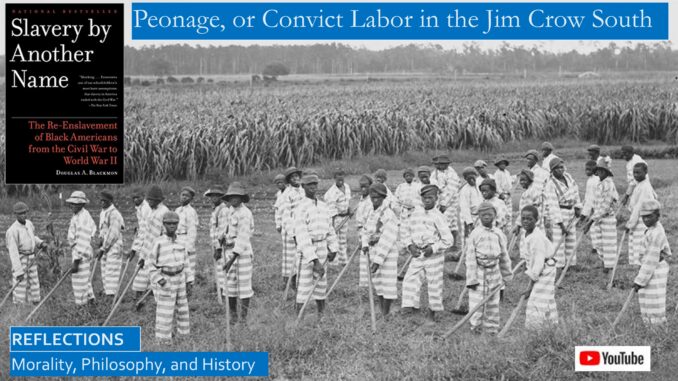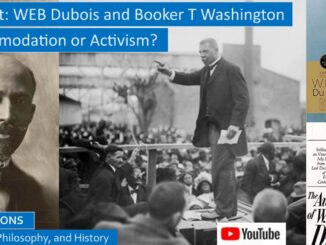
In this blog we will reflect on the Pulitzer Prize winning book by Douglas Blackmon, Slavery by Another Name, with the subtitle, The Re-Enslavement of Black Americans from the Civil War to World War II. This book documents both on an individual level and historically how the convict labor system worked in the Deep South. These convict labor camps were often every bit as brutal as the Siberian gulag labor camps in Russia under Stalin, in both systems many of the prisoners died from overwork, neglect, abuse, and starvation.
YouTube video for this blog: https://youtu.be/2TCXcEpohaM
YouTube script with book links: https://www.slideshare.net/BruceStrom1/slavery-by-another-name-convict-labor-in-the-jim-crow-deep-south
THIRTEENTH AMENDMENT
The 13th Amendment contained a fatal loophole that caused much suffering and death. The text of this amendment is: Neither slavery nor involuntary servitude, except as a punishment for crime whereof the party shall have been duly convicted, shall exist within the United States, or any place subject to their jurisdiction.
To take advantage of this loophole, the former Confederate states passed harsh vagrancy laws that criminalized “loafing,” which meant that any black person who was picked up by the law in a southern town was thrown in jail so he could be leased out to plantation owners under the overseer’s whip, like it was under slavery, or they were leased out to other businesses such as factories, railroads, brick kilns, and mines. Convict leasing was brutal, sometimes convict laborers died on the job. These convict laborers were often treated worse than slaves had been treated, slaves had been valuable property before the Civil War, they were worth as much then as economy cars are worth now, but now after the Civil War the life of a black freed man literally had no value.
Saying that after the Civil War the life of a black man had no value does sound rather harsh and degrading, this comment has been made by many scholars, including the former Yale professor in his YouTube videos of his undergraduate classes on Black History, and he confirms that this comment is as harsh as it is true.
This link between democracy and justice is first seen in the history of ancient Greece. When you study the history of the radical democracy in ancient Athens, what is clear is that democracy and trials by jury, and a fair judicial system, developed together, hand in glove. When the government is not fair and equitable, neither is the judicial system fair and equitable.
Likewise, the black man had been disenfranchised in the former Confederate States by 1901, and also by this time that judicial system of these states denied due process to all black citizens, in violation of the spirit of the 14th Amendment, though the Supreme Court interpreted it so narrowly that, for practical purposes, it no longer applied to black citizens, but only protected corporations, which did not need protection.[1]
WEB Dubois observes, “If a white man is assaulted by a white man or a Negro the police are at hand. If a Negro is assaulted by a white man, the police are more apt to arrest the victim than the aggressor.”[2] Blackmon cites a case where many former slaves filed suit in 1868 seeking payment for the prior year’s wages. The whites responded by burning down the courthouse along with the paperwork for 1,800 lawsuits for these cases.[3]
WEB Dubois, in his book Black Reconstruction, quotes this account, “In some states where convict labor is sold to the highest bidder, the cruel treatment” is beyond description. “Prison inspectors find convicts herded together, irrespective of age; confined at night in shackles; sometime packed like sardines in old box cars. During the day they work under armed guards, who stand ready to shoot down any who may attempt to escape from this hell on earth.” “Should one escape, the bloodhounds track them down,” and when they are “brought back, they are severely flogged and put in double shackles, or worse.”[4]
Blackmon says this about convict labor, “The quasi-slavery of the twentieth century was rooted in the nascent industrial slavery that flourished in the last years of the Civil War. The same men who built railroads with thousands of slaves and proselytized for the use of slaves in southern factories and mines in the 1850’s were also the first to employ forced African American labor in the 1870’s.”[5] Most southern states enacted vagrancy laws by 1865 that were so vaguely worded that any blacks could be arrested if they were on the streets and not working, some states enacted laws making it illegal for black workers to change employers without permission.[6]
The convict labor system was strongest in the Black Belt, the rich cotton farmland stretching from South Carolina through Georgia, Alabama, Mississippi and Louisiana. As Blackmon states, “here the moral rationalization of slavery, and the view of slaves as the essential proof of white men’s royal status, became as fundamental to white’s perception of America as the concept of liberty itself. A century later, this was the paradox of the post-Civil War South, recognition of freed slaves as full humans appeared to most white southerners not as an extension of liberty but as a violation of their liberty, and as a challenge to the legitimacy of their definition of what it was to be white.”[7]
Working conditions were brutal for convict laborers, the companies working them had no supervision, they could chain them, whip them, or even shoot them when they tried to escape. In the worst cases, they were starved and brutalized. In the first two years convicts were leased in Alabama, one in five died, by the fourth year, nearly half of the convict laborers died in Alabama.[8] State inspectors said this about private prisons for convict workers in Birmingham, Alabama: they were “totally unfit for use, without ventilation, without adequate water supplies, crowded to excess, filthy beyond description.” Prisoners were “poorly clothed and fed, cruelly punished; there were no hospitals; the sick were neglected; and they were so intimidated” that they dared not say anything about their maltreatment.[9]
The conditions and laws got worse as the years progressed. In most southern states, local sheriffs and deputies were not paid salaries, they were instead paid from court fees, and they kept any excess from the feeding fees paid by the state, encouraging them to starve the prisoners. New laws were passed so more blacks could be convicted on trivial offenses so more could be leased out. Sharecroppers who failed to pay their bogus debts could be prosecuted for fraud. The truly innocent could be coerced into the convict labor system to pay for the crimes of their relatives. Convicts were sometimes retained indefinitely if they could not pay inflated court costs.[10] There were cases where blacks were kidnapped, forced to pay bogus fines for bogus crimes, and forced to labor for months and years without any pay.[11] The creativity was as boundless as the cruelty of the enslavement.
THEODORE ROOSEVELT, THE BULLY PRESIDENT
Some changes were made under Theodore Roosevelt, the bully President. Vice President Theodore Roosevelt became President when William McKinley was assassinated in September 1901. Earlier that year he had accepted an invitation to speak at the black leader Booker T Washington’s school, the Tuskegee Institute, and later Washington recommended a moderate for an important US District Court judge. Roosevelt invited the black educator to a private dinner in the White House but was shocked at the outrage in the South for his inviting a colored man to dine with his wife and children! Senator Tillman of South Carolina ranted, “Now that Roosevelt has eaten with that nigger Washington, we shall have to kill a thousand niggers to get them back to their places.” The governor of Georgia said, “No southerner can respect any white man who would eat with a negro.”
But then in May of 1903, under the Roosevelt Administration, something else unthinkable happened, a federal Secret Service detective was interviewing blacks about labor practices related to convict labor.[12] They had no idea. Federal authorities discovered multiple slavery rings in Alabama, in Lowndes county they estimated there were thousands of convict laborers hired by dozens of local landowners.[13]
US Attorney Reese said this about the widespread practice: “Peonage is crueler and more inhuman than the slavery of antebellum days, since then the master conserved the life and health of the slave for business reasons just as he did that of his horse or mule, but now the master treated the slave unmercifully and with the sole object of getting the greatest possible amount of labor out of him. Moreover, a peon costs but a few dollars while a slave used to cost several hundred dollars.”[14]
Forty years after Lincoln emancipated the slaves, the first men in Alabama were indicted by a grand jury for illegally holding slaves. The defendants insisted that they were the friends of the blacks, that everything they did was legal, except they had to admit that sometimes paperwork was missing. There were frequent and flagrant attempts to intimidate and tamper with the dirt-poor black witnesses. The grand jury in Montgomery, Alabama, returned sixty-three indictments. In addition, Attorney General Knox detected dozens of other cases of peonage across Alabama, Georgia, and northern Florida.[15] The national press was covering these proceedings, causing shock and embarrassment over these cruelties, which slowly helped change public opinion, very slowly.[16]
Coaxing a grand jury to indict was far less problematic than persuading a white jury to convict fellow whites for peonage. Some defendants who pled guilty were, to their surprise, sentenced to serve short prison sentences. But for at least one case covered by Blackmon, there were likely more, the white jury refused to convict their fellow white man for peonage, even when the evidence was overwhelming. This meant that many of the guilty were set free after pleading guilty after agreeing to pay a small fine.[17]
The lynchings, the violence, the peonage continued, one black minister even complained that his young daughter had been kidnapped and local authorities would not help with her return. In Louisiana, a federal marshal investigating convict labor cases was forced to flee for his life. This Roosevelt Administration just threw up their hands, this was not a problem they could solve in the face of widespread resistance, as southern juries could not be relied on to convict.[18]
THE BRUTALITY OF PEONAGE CONTINUES
The brutality of peonage continued through the 1930’s. In 1912, the racist segregationist southern Woodrow Wilson was elected president, assuring that the federal government would not pursue civil rights cases. Lynchings continued, blacks were denied the vote and due process, and after the black veterans returned from fighting in World War I, insisting on their civil rights, knowing how to bear arms, race riots erupted in many cities, burning down black homes and businesses with no compensation, and no justice.
Even in ancient times, where slavery was more benign, there were two truths in any system of slavery. First, women slaves were quite often sexually assaulted, and since they were property, this was not a crime. Second, the worst type of slave was the slave who worked in the mines deep below the earth.
In the Deep South, white men always could take advantage of black girls. Blackmon tells us how black girls were abused when they inquired about their incarcerated relatives or husbands. It was common practice in many prisons for “girls to come around to the jailer’s room for an hour of sex in exchange for a favor to their man inside.” Worse, “at the lumber camps in southern Alabama, “women seeking the freedom of their men were simply arrested when they arrived, chained into their cells, and kept to sexually service the men running the camps. The slave camps and mines produced scores of babies, nearly all of them with white fathers.”[19]
Soon after Emancipation, Booker T Washington worked in the coal mines as a young man before he was able to go to school. He was not a convict laborer, so he quit as soon as he could. Booker remembers working in the coal mine, “the work was not only hard, but it was also dangerous. There was always the danger of being blown to pieces by a premature explosion of powder, or of being crushed by falling slate. Accidents were frequent, we were in constant fear.” Many small children worked in the coal mines, with no hope of gaining an education. “Young boys who begin life in a coal-mine are often physically and mentally dwarfed. They soon lose ambition to do anything else than to continue as a coal miner.”[20]
Blackmon chronicles the brutal condition of the Pratt slave mines in Alabama. “Inside the mine shafts deadly gases accumulated in unventilated sections. Work continued even as water, seeping from the walls and fouled with the miner’s waste and excrement, accumulated in the shafts. Intestinal disorders, malaria, pneumonia, and respiratory problems dogged the men. Endless contact with coal dust led to black lung disease, a miserable and certain slow death.”
“Hardly a week passed that accidents didn’t take men’s fingers, hands, toes, or worse. Often the cause was a careless swing of a pick. But almost as frequently men were crushed by coal falling before they expected or pinned by railroad cars that derailed. Sometimes miners died by touching a live wire.” And often younger boys were molested by the older men.[21]
In 1908 the Georgia Legislature established a commission to examine the state’s convict leasing system, they found that over three thousand blacks lived in forced labor camps, and that over six hundred black convict laborers had been resold to other firms. In one camp, inmates with tuberculosis were left to die in a shed. Blackmon notes, that witnesses told the commission that the prisoners working in a brickyard kiln were “fed rotting and rancid food, housed in barracks rife with insects, driven by whips into the hottest and most intolerable areas of the plant, and continually required to work at a constant run in the heat of the ovens. The plant was so hot that the guards didn’t carry guns for fear their cartridges would explode.” There was much worse testimony. The next year, with newspaper headlines blaring, the convict leasing system was abolished in Georgia. Several other states abolished convict leasing, some others re-established it, and then in place of leasing came another reform: the chain gang![22]
FREEDOM AT LAST FROM PEONAGE
America would experience an event that would lead, finally, to the federal government ending the practice of convict labor in America. That was the day that would live in infamy, December 12, 1941, when the Japanese forces attacked Pearl Harbor. FDR knew that the fascist enemies of America would exploit any news that blacks were being exploited in our country. It was only five days after the attack that Attorney General Biddle issued a directive to all federal prosecutors should no longer ignore cases of involuntary servitude, or convict labor. In a wartime speech, Biddle proclaimed, “One response of this country to the challenge of the ideals of democracy made by the new ideologies of Fascism and Communism has been a deepened realization that the values of our government must be based on a belief in the dignity and rights of man.”
These cases would now be vigorously prosecuted. Blackmon writes, “As the war progressed, the Department of Justice vigorously prosecuted US Sugar Company in Florida for forcing black men into their sugarcane fields. Sheriffs who colluded with the company were brought to trial.” Blackmon does not describe widespread resistance to this new policy, there was only a small number of prosecutions, time had changed. Black soldiers who returned home in this World War refused to be docile, sometimes moving north for better opportunities, and would later participate in the civil rights movement that swept the country.[23]
As Martin Luther King later later said, “There comes a time when the cup of endurance runs over, and men are no longer willing to be plunged into the abyss of despair.”
[1] Douglas Blackmon, Slavery By Another Name, p. 7.
[2] WEB Dubois, Black Reconstruction (New York: The Free Press, 1935, 1962, 1998), p. 699.
[3] Douglas Blackmon, Slavery By Another Name, p. 19.
[4] WEB Dubois, Black Reconstruction, p. 698.
[5] Douglas Blackmon, Slavery By Another Name, p. 8.
[6] Douglas Blackmon, Slavery By Another Name, pp.53-54.
[7] Douglas Blackmon, Slavery By Another Name, p. 41.
[8] Douglas Blackmon, Slavery By Another Name, pp.56-57.
[9] Douglas Blackmon, Slavery By Another Name, p. 73.
[10] Douglas Blackmon, Slavery By Another Name, pp.63-69.
[11] Douglas Blackmon, Slavery By Another Name, pp.148-150.
[12] Douglas Blackmon, Slavery By Another Name, pp.156-167.
[13] Douglas Blackmon, Slavery By Another Name, p. 176.
[14] Douglas Blackmon, Slavery By Another Name, p. 218.
[15] Douglas Blackmon, Slavery By Another Name, p. 220.
[16] Douglas Blackmon, Slavery By Another Name, pp.187-211.
[17] Douglas Blackmon, Slavery By Another Name, pp.217-232.
[18] Douglas Blackmon, Slavery By Another Name, pp.246-255.
[19] Douglas Blackmon, Slavery By Another Name, p. 305.
[20] Booker T Washington, Up From Slavery, Chapter 2, p. 18.
[21] Douglas Blackmon, Slavery By Another Name, p. 317.
[22] Douglas Blackmon, Slavery By Another Name, pp.338-354.
[23] Douglas Blackmon, Slavery By Another Name, pp.377-381.




Be the first to comment